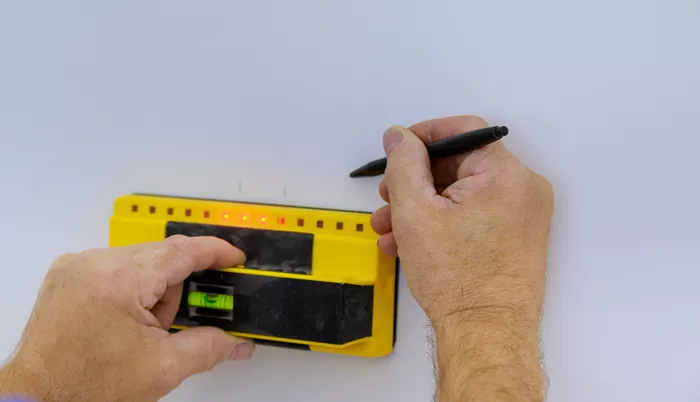Stud finders are essential tools for anyone looking to perform precise and safe wall drilling, mounting, or construction tasks. Understanding how a stud finder works can help you choose the right type and use it effectively. This article delves into the workings of stud finders, exploring the different types and their operational mechanisms.
Overview of Stud Finders
Stud finders, also known as stud detectors or stud sensors, are devices used to locate framing studs behind wall surfaces. These tools are particularly useful for hanging heavy items, such as mirrors, shelves, or televisions, ensuring that the weight is supported by the underlying wooden or metal studs.
Types of Stud Finders
There are primarily three types of stud finders: magnetic, electronic, and radar-based. Each type operates on a different principle, providing various levels of accuracy and ease of use.
1. Magnetic Stud Finders
Operation Principle
Magnetic stud finders use powerful magnets to detect the metal fasteners (nails or screws) that secure the drywall to the studs. When the magnet locates a metal fastener, it sticks to the wall, indicating the presence of a stud.
Features
Simplicity: Magnetic stud finders are simple and inexpensive.
No Power Required: They do not need batteries or any power source.
Limited Accuracy: They rely on the presence of metal fasteners, which may not be consistently spaced or aligned.
See also: How To Find A Stud Without A Stud Finder?
2. Electronic Stud Finders
Operation Principle
Electronic stud finders operate by measuring changes in the wall’s dielectric constant, which varies when moving from an area of drywall to a denser material like wood or metal. The device sends out an electronic signal, and when it detects a change, it indicates the presence of a stud.
Features
High Accuracy: Electronic stud finders provide more accurate results compared to magnetic ones.
Additional Features: Many models come with features like depth detection, live wire detection, and center-of-stud indication.
Power Requirement: They require batteries to operate.
3 .Radar-Based Stud Finders
Operation Principle
Radar-based stud finders use radar technology to detect studs. These advanced devices emit radar pulses that penetrate the wall and bounce back upon hitting a stud or other object. The device processes these signals to provide a detailed map of the wall’s interior.
Features
Advanced Detection: They can detect a variety of objects within the wall, including pipes and wires.
High Precision: These devices offer high precision and can provide information on the type and size of the objects detected.
Expensive: Radar-based stud finders are typically more expensive and are used in professional applications.
Using a Stud Finder
Using a stud finder correctly involves a few simple steps to ensure accurate detection.
Preparation
Power Source: Ensure the stud finder has fresh batteries if it’s an electronic model.
Calibration: Some electronic stud finders require calibration. Place the device on the wall, turn it on, and let it calibrate itself before scanning.
Scanning the Wall
Position the Stud Finder: Place the stud finder flat against the wall, starting from one side of the area where you intend to locate studs.
Move Slowly: Slowly slide the stud finder horizontally across the wall. For magnetic finders, you will feel the magnet stick when it finds a fastener. For electronic finders, the device will beep or light up to indicate a stud.
Mark the Stud Locations: Once a stud is detected, mark its location on the wall. Move the stud finder to the left and right to confirm the edges of the stud, marking these as well to determine the stud’s center.
See also: How To Use A Stud Finder?
Applications of Stud Finders
Stud finders are used in various applications, including:
Hanging Heavy Objects: Ensuring that heavy items are securely mounted to studs.
Construction and Remodeling: Locating studs for framing and structural modifications.
Safety Checks: Avoiding hazards by detecting live wires and pipes within walls.
Tips for Effective Use
Consistency: Move the stud finder consistently to avoid false readings.
Multiple Passes: Make multiple passes over the same area to confirm stud locations.
Check Battery: Ensure the battery is fresh to maintain the accuracy of electronic stud finders.
Combine Tools: Use a combination of stud finders and other detection tools for comprehensive wall scanning.
Conclusion
Stud finders are indispensable tools for anyone performing wall-mounted tasks. Understanding how they work and the differences between magnetic, electronic, and radar-based models can help you choose the right tool for your needs. By following the correct usage techniques, you can ensure accurate detection and safe, secure mounting for all your projects.
Related Topics:
-
Top 5 Shop Vacs Of 2024: An In-Depth Evaluation Of Performance And Features
-
Craftsman Air Compressor Review: Is It Worth The Investment?
-
Evaluating Chainsaw Sharpeners: Which Model Offers The Best Performance?
-
Tapcon Screws Vs. Traditional Fasteners: Which Is Best For Your Project?

